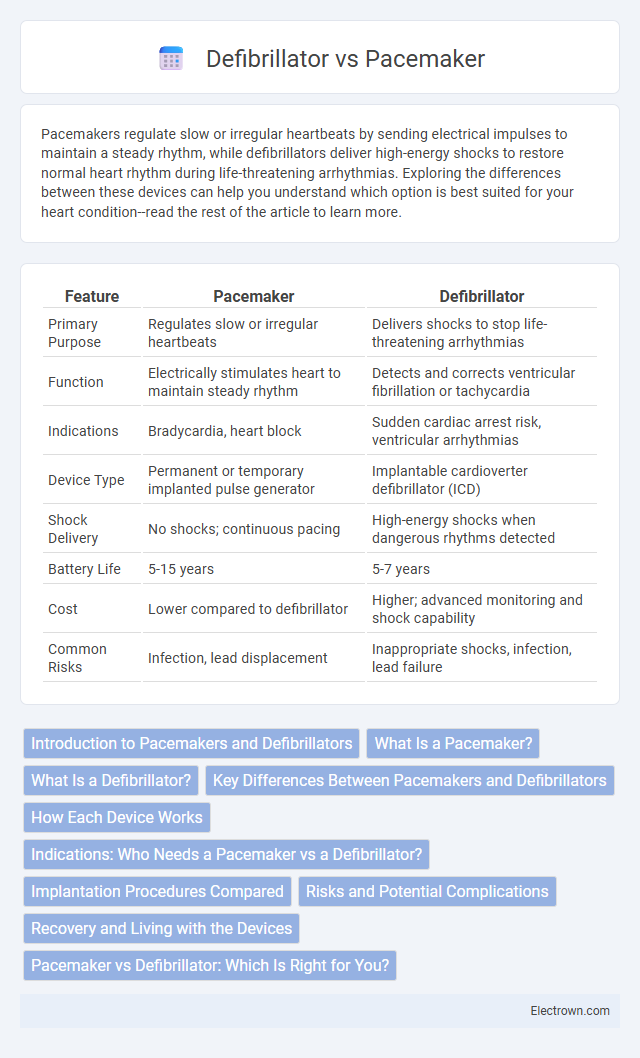Pacemakers regulate slow or irregular heartbeats by sending electrical impulses to maintain a steady rhythm, while defibrillators deliver high-energy shocks to restore normal heart rhythm during life-threatening arrhythmias. Exploring the differences between these devices can help you understand which option is best suited for your heart condition--read the rest of the article to learn more.
Table of Comparison
| Feature | Pacemaker | Defibrillator |
|---|---|---|
| Primary Purpose | Regulates slow or irregular heartbeats | Delivers shocks to stop life-threatening arrhythmias |
| Function | Electrically stimulates heart to maintain steady rhythm | Detects and corrects ventricular fibrillation or tachycardia |
| Indications | Bradycardia, heart block | Sudden cardiac arrest risk, ventricular arrhythmias |
| Device Type | Permanent or temporary implanted pulse generator | Implantable cardioverter defibrillator (ICD) |
| Shock Delivery | No shocks; continuous pacing | High-energy shocks when dangerous rhythms detected |
| Battery Life | 5-15 years | 5-7 years |
| Cost | Lower compared to defibrillator | Higher; advanced monitoring and shock capability |
| Common Risks | Infection, lead displacement | Inappropriate shocks, infection, lead failure |
Introduction to Pacemakers and Defibrillators
Pacemakers and defibrillators are critical cardiac devices designed to regulate heart rhythm and prevent sudden cardiac arrest. Pacemakers continuously monitor and maintain a steady heartbeat by sending electrical impulses to the heart muscles, while defibrillators detect dangerous arrhythmias and deliver high-energy shocks to restore normal rhythm. Understanding the specific functions of each device helps you choose the most appropriate treatment for managing heart conditions.
What Is a Pacemaker?
A pacemaker is a small, battery-powered device implanted under the skin to regulate abnormal heart rhythms by sending electrical impulses to stimulate the heart to beat at a consistent rate. It is primarily used to treat bradycardia, a condition characterized by a heart rate that is too slow, ensuring adequate blood flow and oxygen delivery throughout the body. Pacemakers are carefully programmed to match the patient's specific cardiac needs, improving symptoms like fatigue, dizziness, and fainting caused by irregular heartbeats.
What Is a Defibrillator?
A defibrillator is a medical device designed to deliver an electric shock to the heart to restore a normal heartbeat during life-threatening arrhythmias such as ventricular fibrillation or ventricular tachycardia. It monitors the heart's rhythm and automatically detects irregularities requiring intervention, making it crucial in emergency cardiac arrest situations. Unlike pacemakers, defibrillators provide high-energy shocks rather than continuous electrical pacing.
Key Differences Between Pacemakers and Defibrillators
Pacemakers regulate slow or irregular heartbeats by sending electrical impulses to maintain a regular rhythm, while defibrillators monitor and correct life-threatening arrhythmias through high-energy shocks. Pacemakers are primarily used for bradycardia, whereas defibrillators address severe ventricular fibrillation or tachycardia to prevent sudden cardiac arrest. Understanding these key differences helps you choose the appropriate device based on your specific cardiac condition.
How Each Device Works
A pacemaker regulates slow heart rhythms by delivering small electrical impulses to stimulate the heart to beat at a normal rate. A defibrillator, often an implantable cardioverter-defibrillator (ICD), detects life-threatening arrhythmias and delivers a high-energy shock to restore a normal heartbeat. While pacemakers primarily address bradycardia, defibrillators respond to tachyarrhythmias such as ventricular fibrillation or ventricular tachycardia.
Indications: Who Needs a Pacemaker vs a Defibrillator?
Pacemakers are primarily indicated for patients with bradycardia or heart block, conditions where the heart beats too slowly or irregularly, requiring electrical impulses to maintain a proper rhythm. Defibrillators, or implantable cardioverter-defibrillators (ICDs), are essential for individuals at high risk of sudden cardiac arrest due to ventricular tachycardia or fibrillation. Your cardiologist will determine whether you need a pacemaker for pacing support or a defibrillator for life-saving shock therapy based on your specific heart condition.
Implantation Procedures Compared
Pacemaker and defibrillator implantation procedures both involve placing a device under the skin near the collarbone, but a defibrillator's leads are typically positioned in the heart's chambers to monitor and correct dangerous arrhythmias, while a pacemaker primarily focuses on regulating slower heartbeats. The surgical process for both devices requires threading leads through veins into the heart, but defibrillator implantation is generally more complex due to the need for additional sensing and shock-delivery capabilities. Your cardiologist will determine the best procedure based on your specific cardiac condition and treatment goals.
Risks and Potential Complications
Pacemakers and defibrillators carry risks such as infection, bleeding, or lead displacement following implantation. Potential complications include device malfunction, which can result in inappropriate pacing or shocks, and rare occurrences of blood clots or allergic reactions to materials. Understanding these risks helps you make informed decisions regarding treatment and follow-up care.
Recovery and Living with the Devices
Recovery after receiving a pacemaker typically involves a short hospital stay and minimal restrictions, allowing most patients to resume normal activities within a few weeks, while defibrillator patients may require closer monitoring due to the device's role in preventing sudden cardiac arrest. Living with a pacemaker demands routine check-ups to ensure proper pacing and battery function, whereas defibrillator recipients must manage lifestyle adjustments to accommodate potential shocks and device programming. Both devices necessitate ongoing medical follow-up and lifestyle modifications to optimize heart health and device performance.
Pacemaker vs Defibrillator: Which Is Right for You?
Pacemakers and defibrillators are both essential cardiac devices but serve different purposes; pacemakers regulate slow or irregular heartbeats by sending electrical impulses, while defibrillators detect and correct life-threatening arrhythmias through high-energy shocks. The choice depends on individual heart conditions such as bradycardia for pacemakers or risk of sudden cardiac arrest for defibrillators. Consulting a cardiologist for personalized evaluation, including heart function tests and arrhythmia diagnosis, determines the appropriate device for optimal cardiac health management.
Pacemaker vs Defibrillator Infographic

 electrown.com
electrown.com